Note from the Author: The enigmatic Kolbrin contains alongside its Celtic records six ancient Egyptian books, the remnants of scrolls written or copied by scribes from much earlier writings whose provenance has not yet been proven. Most people dismiss the books as forgeries. I am convinced that their core material is genuine.
If you had to name the most devastating disaster known to humanity, what would it be? Most people think of disasters occurring within their own lifetime like the Indian Ocean Tsunami of 2004. Historians might come up with the Black Death in the 14th century, the 1883 eruption of Krakatoa or Spanish Flu in 1918. A few people might recall hazy memories of the Book of Genesis and mutter something about The Flood, but mainstream thinking maintains there was ‘No worldwide flood, ever’i – though recent geological discoveries are starting to nibble away at this cornerstone theory of slow, gradual global changeii.
According to the enigmatic books of the Kolbrin, ‘The Flood’ would be almost, but not quite the right answer to this question. Among several accounts of major global cataclysms which include floods, its Egyptian books speak of two almost total destructions: ‘Earth was destroyed twice, once altogether by fire and once partially by water’… ‘The destruction by water,’ it states, ‘was the lesser destruction.’iii
Two Flood stories
The Kolbrin contains, not one, but two versions of the worldwide Flood story, one in the Egyptian Book of Gleanings and one in the Celtic Book of Origins. In a veritable ocean of flood myths, why do these two stand out?
The Deluge story in the Egyptian Book of Gleanings
The names in this Kolbrin versioniv suggest an ancient Sumerian source; it indicates when the Flood took place, where the Ark was built and where it came to rest, giving more circumstantial detail than the poetic Atrahasisv and Gilgameshvi epics or the clipped Genesisvii prose version. Above all, it says loud and clear what caused the Great Flood – something no other written account does – and explains why human beings have forgotten the more important aspects of an event which by rights should be standing firmly at the centre of world knowledge, not mouldering away on the dusty bookshelf of myth.
The Floodtale in the Celtic Book of Origins
The second version of the Flood storyviii came to Britain as an oral retelling and was written down between the first and fifth centuries ADix. It was brought by a ‘far-ranging race from Krowkasis [the Caucasusx], the Motherland where Gatuma ruled, where sky-reaching mountains rise out of a wide, green, dark-soiled plain. They were horse-fighters, known among themselves as the Wildland Cultivators… It was the Wildland Cultivators who gave the flood-tale to our housebuilding forebears, but the generation of its happening is lost.’ What makes this story special is that it reveals there was not one Ark, but two. More on this later.
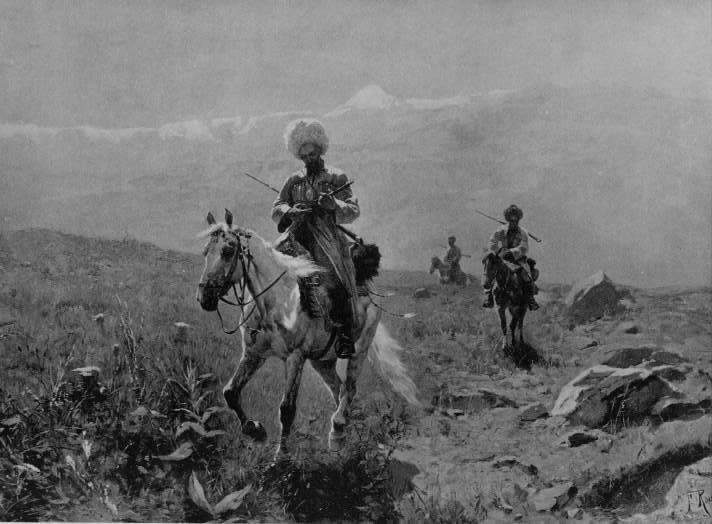
Horsemen of Caucasus, 1894. Franz Alekseyevich Roubaud (1856-1928). https://commons.wikimedia.org/w/index.php?curid=10939459
Dating the Flood
The Book of Gleanings Flood story is immediately followed by the epic of a hero called Hurmenatar (who by his story is easily identified as the hero Gilgameshxi), and buried in it is this difficult passage:
‘Wisdom came to the land by the hand of our father Hurmanetar called Hankadah [Gilgamesh], born at Egelmek in the land of Khalib under Eraka … of Nintursu, Maiden of the Temple, by Gelamishoar, Builder of Walls, son of Lugadur the Metalworker, son of Dumath the Shepherd son of Gigitan the Tiller of the Soil… Nintursu was the last of the line of Sisuda… One hundred generations had passed since the overwhelming deluge…xii’
The lines are difficult because, as elsewhere throughout the Kolbrin, many of the names have become skewed. They can be identified as follows:
Eraka – Erech/Uruk
Nintursu – Ninsun/Ninsumun
Lugadur – Lugalbandur
Dumath – Dumuzid
Sisuda – Ziusudraxiii
We know the names of these historic rulers, the length of their reigns and the cities where they ruled because they exist in the Sumerian King List, an ancient text existing in various parts; the most extensive list can be seen in the Ashmolean Museum, Oxford.
The passage above reveals some extraordinary chronological information which needs a bit of unpacking. The Kolbrin says that Hurmanetar/Gilgamesh inherited noble genes on both sides: his mother was Nintursu/Ninsun, last in the line of King Ziusudra (listed in the Sumerian king list as Ziusudra/Zin-Suddu of Shuruppak, the last king of Sumer before a great flood); his father Gelamishoar came of a line of Uruch rulers who included Lugardur/Lugalbandur and Dumath/Dumuzid; these can also be found in the Sumerian King List. The King List states that Gilgamesh was the fifth historical king to rule the city-state of Uruk/Erech. Historians think that Gilgamesh ruled about 2700 BC.xiv
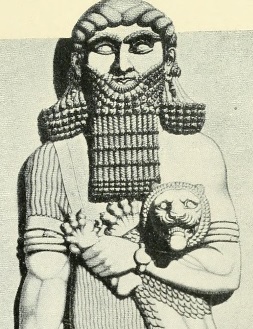
Gilgamesh illustration, Myths and legends of Babylonia & Assyria, Lewis Spence (1916)
Later in the Kolbrin epic it says: ‘Once man lived for less than two score years, now his years were three score and ten.’xvThis matches the Old Testament rule of thumb whereby a generation is reckoned to be 70 yearsxvi, so the ‘one hundred generations’ which passed after the ‘overwhelming Deluge’ can be reckoned at 7,000 years. If the Flood took place 100 generations before the reign of King Gilgamesh in c.2700 BC, then a simple calculation (1000 x 70 + 2700) dates it to roughly 9,700 BC. This falls within the time-span of a global catastrophic period known as the Younger Dryasxvii.
A Sumerian flood story
Most of the events in the Gleanings story are set in ‘Shinara’ (skewed Shinar, or ancient Mesopotamia). The story describes the decadent behaviour of people living in two ‘twin cities’ on the Shinara/Shinar plains, and tell how a tough race of men (‘Sons of Nezirah’) come down from the mountains intending to overcome the decadents below – but end up being seduced by their soft ways and settling into a life of luxury and sexual excess, leaving their distraught womenfolk up in the mountains looking after the herds.
The story goes on to speak of a city named ‘Sharepik, now called Sarapesh’ ruled by a king called Sisuda. These names link the Kolbrin version with existing Sumerian versions – ‘Sharepik’ with the ancient Sumerian city of Šuruppak/Shuruppak on the banks of the River Euphrates, and ‘Sisuda’ with its king Ziusudra/Xiusudra.xviii
Events now take a climatic turn:
‘One day, from afar off came three men of Ardis, their country having been stricken by a mountain burst. They were worshippers of The One God whose light shines within men, and when they had lived in the two cities for a number of days they were stirred up in their hearts because of the things they saw. So they called upon their God to see these evil things. Their God sent down a curse upon the men of the cities, and there came a strange light and a smoky mist which caught at the throats of men. All things became still and apprehensive, there were strange clouds in the skies and the nights were hung with heaviness. Many days passed before a north wind came and the skies cleared; but then, when women conceived they bore devils. Monstrosities came forth from their wombs, whose faces were terrible and whose limbs were unproportioned…
‘The remnants of the Sons of Nezirah remained upon the mountains which are against Ardis, by the land about the encampment of Lamak [skewed Larak?]. In Ardis there were wise men filled with the inner wisdom, who read The Book of Heaven with understanding and knew the signs. They saw that the deeds of men in all the lands about the mountains had brought them to their hour. Then the day came when The Lady of the Nightxixchanged her garment for one of a different hue, and her form swept more swiftly across the skies. Her tresses streamed out behind in gold and copper, and she rode in a chariot of fire. The people in those days were a great multitude and a loud cry ascended into Heaven.’
Anyone who knows the Epic of Gilgamesh will recognise the loud cry going up to heaven. Less familiar is the place called Ardis. My article https://grahamhancock.com/whitemany7/ described it as a region in the Caucasus where the Sons of God ‘descended’. Ardis can now be identified with Aratta, a legendary city-state which hopeful archaeologists claim to have discovered in two places: north of the Black Sea in Ukrainexx and in Jiroft in Iranxxi. Ardis/Aratta was culturally connected to, but far older than Sumerxxii. The Ukraine location could well have been Ardis. The ancient goddess of the Caucasus/Ukraine areas was Gatumdug, Goddess of the Steppes (‘the Motherland where Gatuma ruled’ in the Kolbrin)xxiii; Arattans underwent an initiation to become ‘Twice Born’ (https://grahamhancock.com/whitemany9/); and this area fits the Kolbrin description of Krowkasis/Caucasus – ’cradleland of our race, land of mountains and rivers’, which was situated ‘beside Ardis’xxiv.
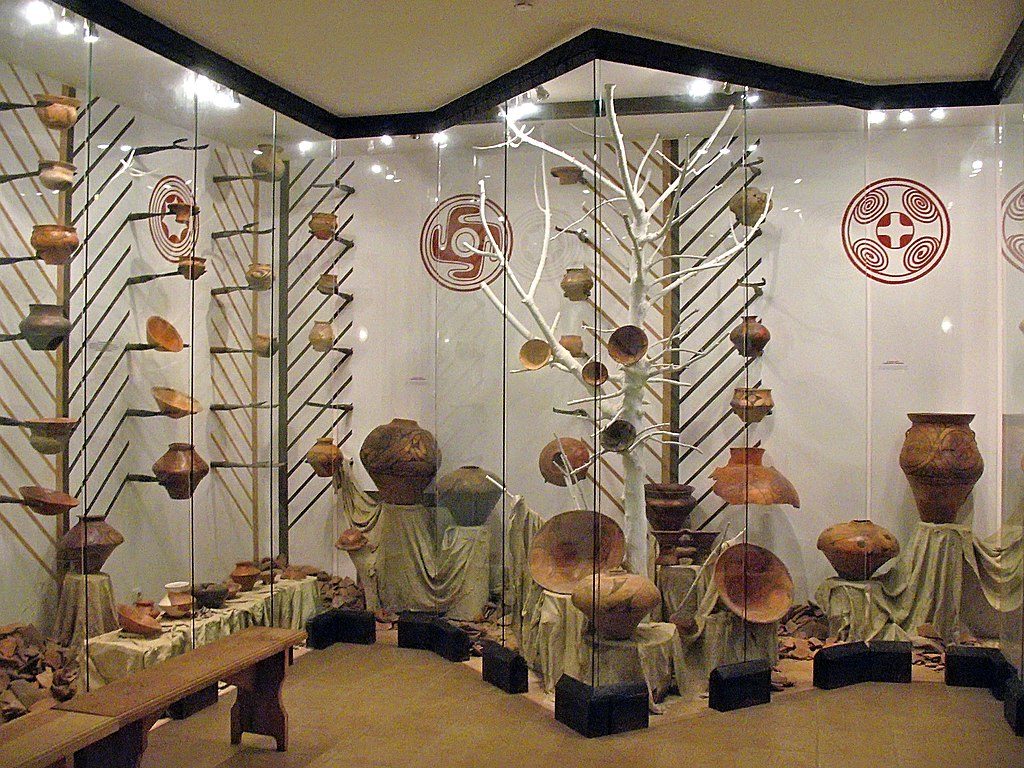
Ancient Aratta Museum, Tryipllya, Ukraine.
Photo: Kiyanka. https://commons.wikimedia.org/w/index.php?curid=66118270
The astronomers’ warning
The Kolbrin goes on: ‘Then the wise men went to Sharepik, now called Sarapesh, and said to Sisuda, the King, "Behold, the years are shortened and the hour of trial draws nigh… Yet, because you have not mingled with the wicked, you are set apart and shall not perish, this so your seeds may be preserved".’
Hanok’s dream
‘Then the king sent for Hanok, son of Hogaretur, and he came out of Ardis, for there he had heard a voice among the reeds saying, "Abandon your abode and possessions, for the hour of doom is at hand; neither gold nor treasure can buy a reprieve".’
The name ‘Noah’ does not appear in the Kolbrin version; instead, he is called Hanok. The Egyptian term Pa-Hanok means ‘House of Enoch’. According to the Book of Genesis, Enoch was the great-grandfather of Noahxxv, so the name ‘Hanok’ refers to a descendant of the House of Enoch. Hanok’s dream warning chimes with the Atrahasis, Gilgamesh and Berossus versions.
The Kolbrin continues:
‘Then Hanok came into the cities and said to the governors, "Behold, I would go down to the sea and would therefore build a great ship, that I may take my people upon it. With me will go those who trouble you and they will take the things which cause you concern; therefore, you will be left in peace to your own enjoyment".
‘The governors said, "Go down to the sea and build your ship there, and it will be well, for you go with our blessing". But Hanok answered, "It has been told to me in a dream that the ship should be built against the mountains, and the sea will come up to me". When he had gone away they declared him mad. The people mocked him, calling him Commander of the Sea, but they did not hinder him, seeing gain in his undertaking. Therefore a great ship was laid down under the leadership of Hanok, son of Hogaretur, for Sisuda, king of Sarapesh, from whose treasury came payment for the building of the vessel.’
Hanok begins by saying he wants to build a great ship down by the sea to take away from the cities all those who so object to their decadent urban ways; but once he is granted permission to build his ship, he states his true plan – to build a great ship up in the mountains.
Build a ship in the mountains? Everyone thinks he is mad. However, wise King Sisuda takes to heart his astronomers’ warnings and agrees to subsidise the construction of the vessel.
The River of Gold
The Kolbrin says that Hanok built his great ship ‘on the lake of Namos, close by the river of gold, where it divides’. This mention of a river of gold is intriguing . The adventurer Thor Heyerdahl, while discussing Sumer with Graham Hancock in the late 1990sxxvi, commented, ‘The tombs from the first kingdom of Sumer are full of ornaments and treasures made of gold, silver, platinum and semi-precious stones – things you don’t find in Mesopotamia… How did they suddenly learn… where to go to find gold and all these other things?’
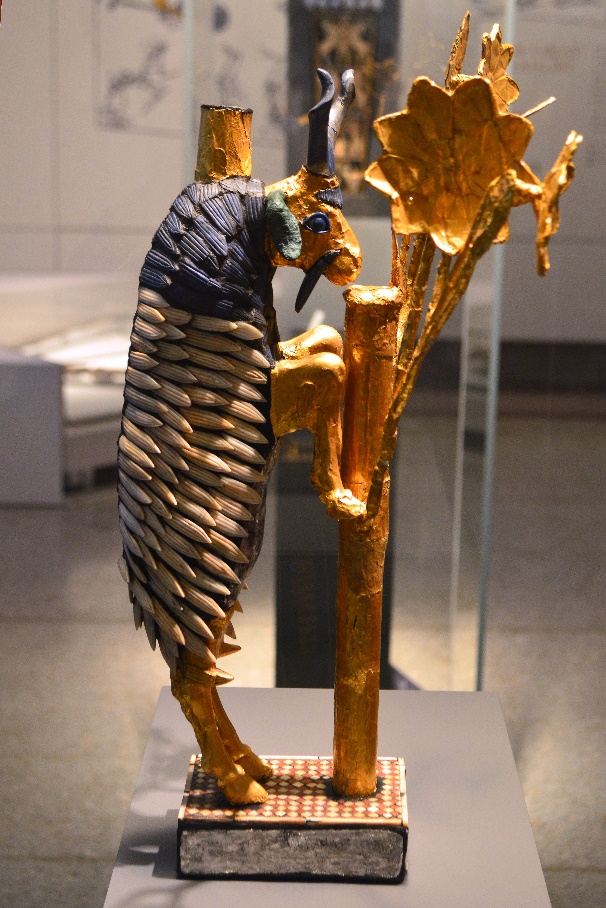
‘Ram in a Thicket’’. This statue and its counterpart in the British Museum are two of the most famous objects from the Royal Cemetery of Ur. They are made from gold, silver, lapis lazuli, copper, shell, red limestone and bitumen. Penn Museum, University of Pennsylvania, USA
Photo: Benjamin82877 https://commons.wikimedia.org/w/index.php?curid=70679283
The Sumerians must have traded with gold-merchants far further afield than historians imagine – for the ‘river of gold’ is not to be found in Mesopotamia, but lies far to the north-east, set among some of the world’s highest mountains on the roof of the world in Tajikistan, central Asia. Over half of Tajikistan is 3,000m/9,800 feet above sea level, the highest peaks reach 5,510m/18,080 ft, and the region is dominated by the Fann Mountains in the Gissar Range of the Pamir-Alay systemxxvii.

Panorama from Mount Chimtarga, the highest point in the Fann Mountains (5,489 metres).
Photo: Oleg Brovko https://commons.wikimedia.org/w/index.php?curid=8783415
Here, north of the Fann Mountains, lies the River Zeravshan (not its original name), which in Persian means ‘gold-bearing’xxviii or ‘spreader of gold’; it is called after the sands pannedxxix in ancient times in the upper reaches of the riverxxx; the waters of the Zeravshan rise in the eastern Turkistan Range and flow hundreds of miles west through Tajikistan and south-eastern Uzbekistan before disappearing in the desert near the Amu Darya river; the Zeravshan was once a tributary of the Amu Daryaxxxi, known in time past as the Oxus, and is mentioned in Greek sources as Polytimetos, but was locally called ‘Namik’.xxxii There is a gold-mine in Tajikistan todayxxxiii and according to the Tajik Government there are known to be more than thirty gold deposits in the statexxxiv.
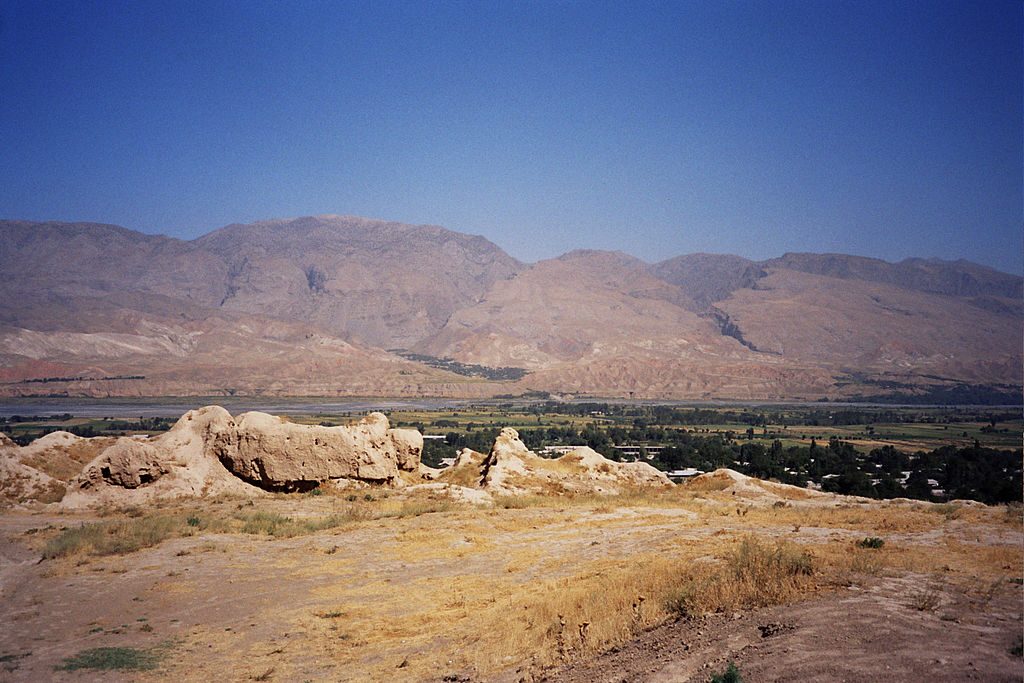
Zeravshan river https://commons.wikimedia.org/w/index.php?curid=29241489
In ancient times this was the land of Soghdia/Sogdia/Soghdiana, a civilisation which developed along the banks of the Zeravshan river. Chinese histories state that much later, during the Han Dynasty (206 BC-220 AD), Chinese settlers built cities along the river, and it is their records which provide us with the River Zeravshan ’s ancient name: ‘Nami’xxxv. The same Chinese records say: ‘The region produced horses and various types of grain’xxxvi; these horse-riding people sound remarkably like the Wildland Cultivators described in the Celtic books, who, judging by their name, were agriculturalists.
The Lake of Namos
Locating Lake Namos is more difficult, since the name has long gone. The Fann Mountains in the western Pamir-Alay mountain system south of the Zeravshan river contain a number of small lakes. Which of them was Lake Nami/the Lake of Namos? The Kolbrin says in its Sumerian Flood story that when the great waters came, ‘the ship… was not dashed upon the mountainside because of the place where it was built’; instead, it ‘rolled’. This suggests it was in a relatively confined space where it could rise up with the floodwaters over the mountaintops without smashing against the sides of high peaks. The Kolbrin gives another clue to the lake: while it was being built, ‘The people of the plains came up and camped about to see this wonder’. This suggests there was a flat lakeside area, which would have been needed for building the great ship.
Soviet engineering and earthquakes over the past century have altered the Zeravshan river and some of its waters are now channelled off into canals. But within a 50-mile range of where the river divides are two likely candidates for Lake Namos: 25 miles away lie the high Kulikalon Lakes on the northern slope of the Fann Mountains’ highest peak, Chimtarga; while 40 miles away in the Gissar Mountain is the most famous lake of all: Iskanderkul.
The Kulikalon Lakes, although described as ‘glacial’, contain no fish because the water has always been bitter and salty – which in itself is a mystery.
Iskanderkul or ‘Alexander Lake’ was renamed by Alexander the Great when he campaigned in Asia between 329 and 328 BC. Situated 2195 metres above sea level, with a flat wooded area on one of its banks, this glacier lake has a surface area of 3.4 square kilometres/1.3 square miles.
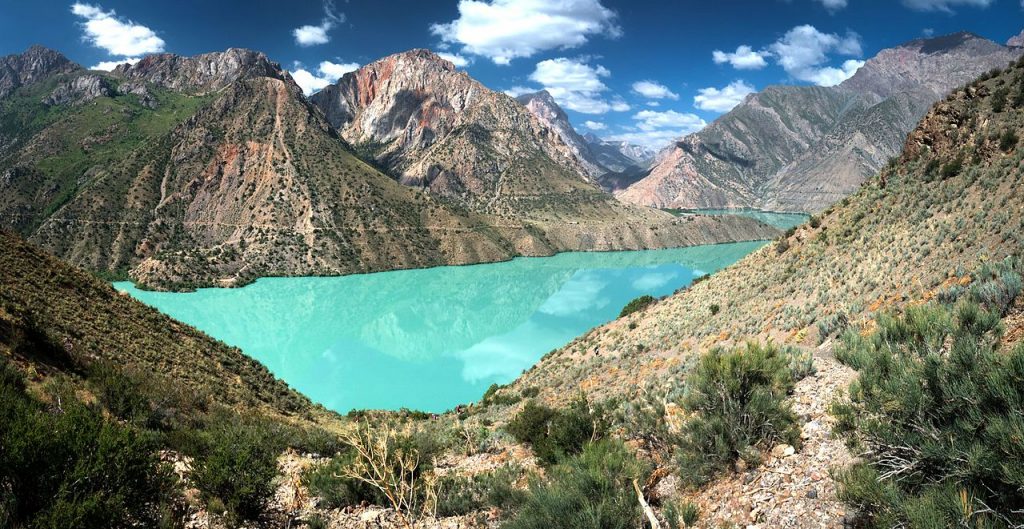
Iskanderkul Lake. Photo: Oleg Brovko https://commons.wikimedia.org/w/index.php?curid=43260301

Map showing Zeravshan River running east-west across top, the point where the river divides most strongly and Iskanderkul Lake circled in red, bottom centre. https://www.youtube.com/watch?v=0eVGB6VgJX8
Video giving a 360-degree view of Iskanderkul Lake
Why is Iskanderkul so much more famous than other lakes in the area? Many legends surround Alexander’s time there, one telling of a town which Alexander unsuccessfully tried to conquerxxxvii. Arrian of Nicomedia, who recorded Alexander’s Asian exploits in his Anabasis of Alexander, is geographically ambiguous and does not refer to this lakexxxviii; however, it is known that in ancient times a settlement existed on its banksxxxix and there must have been some strong reason for people to live beside that particular patch of water. In an area of beautiful lakes, Iskanderkul is spectacular and was clearly known about in Alexander’s time – but what drew Alexander, a man clearly inspired by ancient mysteries, to the lake, and what was it called before he renamed it? These questions need answers.

Tetradrachma showing head of Alexander the Great. Photo: Wolfgang Meinhart https://commons.wikimedia.org/w/index.php?curid=289463
What is known is that the Tajiks, who pride themselves on their cultural individualityxl, maintain an ancient tradition, as do the Armenians further west, that they are descended from Noahxli.
How the great ship was built
Constructing the vessel was an immense family enterprise: ‘All the household of Hanok was there and the household of his brother who directed the men at the task. Dwyvan, captain of ships, from the land beyond Ardis, was overseer of the craftsmen. The women and children carried and the men built.’
The dimensions of the great ship match those given in the Book of Genesis: ‘The length of the great ship was three hundred cubits and its breadth was fifty cubits, and it was finished off above by one cubit.’xlii The Kolbrin adds, ‘It had three storeys which were built without a break…’
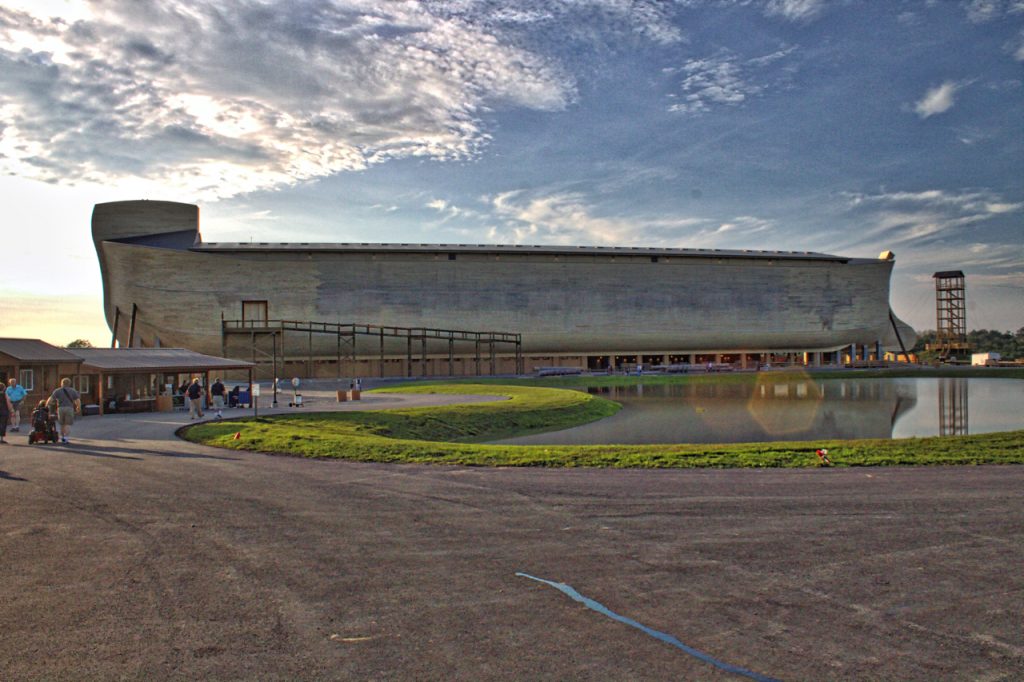
Reconstruction of the Ark at Ark Encounter Theme Park, Kentucky, USA. Photo: Jameywiki https://creativecommons.org/licenses/by-sa/4.0
The Babylonian version of the Flood story uses the word ‘circle’ to describe the vessel, according to Dr Irving Finkel, Assistant Keeper at the British Museum and author of The Ark Before Noah: decoding the story of the Flood. He is convinced that the Ark was built as a giant round coracle; using specifications given in the Atrahasis version of the Flood Story he has had a smaller version of the Ark made along the lines of coracles traditionally used in the southern Iraqi marshes, with ropes woven from palm-fronds on wooden ribs tarred with bitumen.
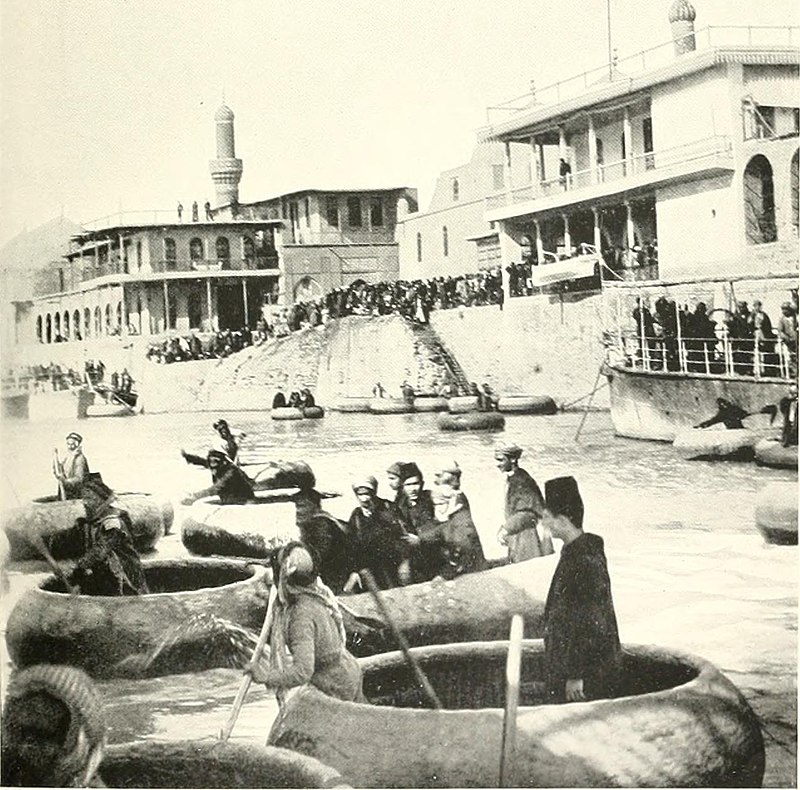
Traditional coracles, By Nile and Tigris : a narrative of Journeys in Egypt and Mesopotamia on behalf of the British Museum between the years 1886 and 1913, E. A. Wallis Budge (1857-1934) https://commons.wikimedia.org/w/index.php?curid=43209305
But the Kolbrin says that this great ship was built of wood and speaks of ‘the planks’ which ‘were edged and the joints made fast with hair and oil’. It ‘was built with askara wood, which water cannot rot or worms enter’. What is ‘askara wood’? Juniper is the tree found all over the Fann Mountains. A kind of cedar, it is rot- and insect-resistant, so it might have been ’askara wood’. The Book of Genesis speaks of ‘gopher wood’, but this has not been identified either.
All versions of the story mention bitumen. The Kolbrin says that the ship ‘was pitched within and without and the cisterns were lined.’ Finding bitumen to pitch the ship would not have been a problem. The Amu Darya Valley is rich in oilxliii and naturally-occurring bitumenxliv. Bitumen, incidentally, was the souvenir taken away from the Mount Judi/Cudi site according to the explorer Gertrude Bell when she travelled there in 1909.
The Kolbrin goes on, ‘Great stones were hung from ropes of plaited leather, and the ship was without mast or oars. There were no poles and no openings, except for a hatch beneath the eaves above whereby all things entered. The hatch was secured by great beams.’ So it appears the ship was designed less for travel and more for staying upright in rough waters.
Describing the different decks, the Kolbrin goes on:
‘The lowermost was for the beasts and cattle and their provender, and it was laid over with sand from the river. The middle one was for birds and fowls, for plants of every kind that are good for man and beast, and the uppermost one was for the people. Each storey was divided in twain, so that there were six floors below and one above, and they were divided across with seven partitions. In it were cisterns for water and storehouses for food… grain was laid up in baskets and many cattle and sheep were slain for meat which was smoked by fire.’
All this detail suggests enormous forethought and organisation.
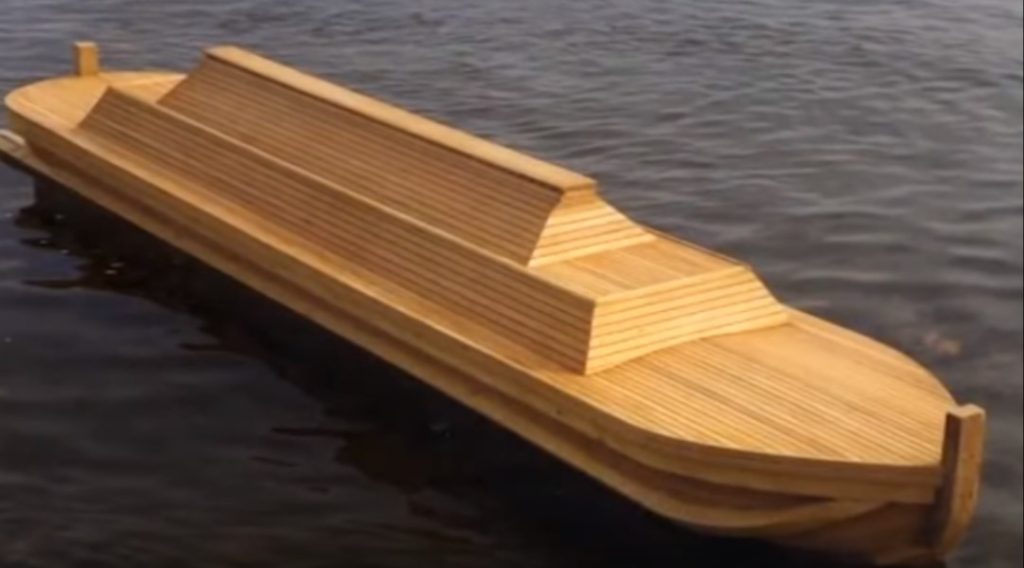
Model of the Ark reconstructed by Ron Wyatt from measurements taken at Durupinar in eastern Turkey. https://www.youtube.com/watch?v=h7MNo5ASK5s
What did they take into the ship?
The Kolbrin continues: ‘Into the great ship they carried the seed of all living things.’ ‘Seed’ is also specified in the Atrahasis and Gilgamesh versions. A couple of sentences later the Kolbrin says that they also ‘took all kinds of beasts of the field and wild beasts, birds and fowls, all things that crawl’, so the ‘seed of all living things’ could mean either the stored DNA of all living creatures and plants, or just the seeds of plants and trees. The idea of stored DNA should not be dismissed out of hand; we have no idea how advanced Hanok and his fellows were. They clearly thought things through and were highly-skilled craftsmen and traders. The same paragraph says they also took ‘gold and silver, metals and stones’ into the ship.
The Kolbrin goes on: ‘The people of the plains came up and camped about to see this wonder… and they daily mocked the builders of the great ship; but these were not dismayed and toiled harder at the task. They said to the mockers, "Have your hour, for ours will surely come"’.
Who went into the ship?
The list of people chosen to go into the ship illustrates the forward thinking behind this enterprise.
‘The king had entered and with him those of his blood, in all fourteen, for it was forbidden that his household go into the ship. Of all the people who entered with him, two understood the ways of the sun and moon and the ways of the year and the seasons. One the quarrying of stones, one the making of bricks and one the making of axes and weapons. One the playing of musical instruments, one bread, one the making of pottery, one the care of gardens and one the carving of wood and stone. One the making of roofs, one the working of timbers, one the making of cheese and butter. One the growing of trees and plants, one the making of ploughs, one the weaving of cloth and making of dyes, and one the brewing of beer. One the felling and cutting of trees, one the making of chariots, one dancing, one the mysteries of the scribe, one the building of houses and the working of leather. There was one skilled in the working of cedar and willow wood, and he was a hunter; one who knew the cunning of games and circus, and he was a watchman. There was an inspector of water and walls, a magistrate and a captain of men.
‘There were three servants of God. There was Hanok and his brother and their households, and Dwyvan and six men who were strangers.
‘On the appointed day, they who were to go with the great ship departed from their homes and the encampment. They kissed the stones and embraced the trees, and they gathered up handfuls of the Earth, for all this they would see no more. They loaded the great ship with their possessions and all their provender went with them. They set a ram’s head over the hatch, pouring out blood, milk, honey and beer. Beating upon their breasts, weeping and lamenting, the people entered the great ship and closed the hatch, making it secure within.’
The event described in no other record
‘Then, with the dawning, men saw an awesome sight. There, riding on a great black rolling cloud came the Destroyer, newly released from the confines of the sky vaults, and she raged about the Heavens, for it was her day of judgement. The beast with her opened its mouth and belched forth fire and hot stones and a vile smoke. It covered the whole sky above and the meeting place of Earth and Heaven could no longer be seen. In the evening the places of the stars were changed, they rolled across the sky to new stations, then the floodwaters came.
‘The floodgates of Heaven were opened and the foundations of Earth were broken apart. The surrounding waters poured over the land and broke upon the mountains. The storehouses of the winds burst their bolts asunder, so storms and whirlwinds were loosed, to hurl themselves upon the Earth. In the seething waters and howling gales all buildings were destroyed, trees were uprooted and mountains cast down. There was a time of great heat, then came a time of bitter cold. The waves over the waters did not rise and fall but seethed and swirled, there was an awful sound above.
‘The pillars of Heaven were broken and fell down to Earth. The sky-vault was rent and broken, the whole of creation was in chaos. The stars in the Heavens were loosened from their places, so they dashed about in confusion. There was a revolt on high, a new ruler appeared there and swept across the sky in majesty.
‘Those who had not laboured at the building of the great ship and those who had mocked the builders came as quickly to the place where it was lying. They climbed upon the ship and beat upon it with their hands; they raged and pleaded, but could not enter inside, nor could they break the wood. As the great ship was borne up by the waters it rolled and they were swept off, for there was no foothold for them. The ship was lifted by the mighty surge of waters and hurled among the debris, but it was not dashed upon the mountainside because of the place where it was built. All the people not saved within the ship were swallowed up in the midst of raging confusion, and their wickedness and corruption was purged away from the face of the Earth.’
Surely, of all the Flood accounts still in existence, this is the most jaw-dropping.
It has been suggested that the Chinese Celestial New Year Water Dragon represents a distant memory of what people saw raging about the heavens above them, while the stylised flaming ‘pearl’ traditionally found beside the dragon could be the ‘beast with her’ which ‘opened its mouth and belched forth fire and hot stones and a vile smoke’.

Detail from the Nine Dragon Screen, Palace Museum, Forbidden City, Beijing, China. Shizhao – https://commons.wikimedia.org/w/index.php?curid=512260
Other versions mention the black cloud, planetary agitation, the opening of heaven’s floodgates and the breaking of Earth’s foundations, terrifying winds, a deafening noise in the sky – but only the Kolbrin makes clear that over and above all this, it was an incoming celestial body which caused the cataclysm. Elsewhere in the Kolbrin the Destroyer is described in detail; prophecies about its next coming pepper the Egyptian and Celtic books; the length of its orbit is given, its part in the Exodus is recorded and it is referred to variously as the Sky-monster, the Scorcher of Heaven, the Day of Visitation, the Revenging Dragon, the Days of Disaster, the Great Trial, the Days of Doom, the Doomshape, the Frightener and the Doomdragon.
A cloud of forgetfulness
Why is the Destroyer – a phenomenon which caused the second greatest destruction of the Earth – now forgotten? Plato referred to its periodic visits in his Timaeus (‘After the usual period of years, the torrents from heaven sweep down like a pestilence, leaving only the rude and unlettered among you. And so you start again like children…’xlv) but his account is usually dismissed as metaphorical; so too did Pliny the Elder, who speaks of Phaeton, the ‘terrible comet’ seen by ‘the people of Ethiopia and Egypt… It had a fiery appearance and was twisted like a coil, and it was very grim to behold; it was not really a star so much as what might be called a ball of fire’xlvi. In ancient Greek literature the Destroyer is reduced to a mythological storm-giant called Typhon’xlvii. The Book of Exodus refers to the Destroyer oncexlviii and the Book of Job oncexlix. But even Sumerian accounts of the Flood do not refer to it. Why not?
The answer is so simple as to be incredible: it was beyond human understanding. The Kolbrin makes this clear in its descriptions of five global catastrophes. It says of the first:
‘Men, stricken with terror, went mad at the awful sight in the Heavens. They were loosed from their senses and dashed about, crazed, not knowing what they did… So awesome was the fearfully aspected thing that the memory mercifully departed from man, his thoughts were smothered under a cloud of forgetfulness… They crept out from caves and came down from the mountainsides. Their eyes were wild and their limbs trembled, their bodies shook and their tongues lacked control. Their faces were twisted and the skin hung loose on their bones… they knew no law, being deprived of all the wisdom they once had and those who had guided them were gone. Man survived, but he was not the same… Henceforth, the placid skies would hold a terrifying secret…
‘When men came forth from their hiding places and refuges, the world their fathers had known was gone forever… One generation groped in the desolation and gloom, and as the thick darkness was dispelled its children believed they were witnessing a new creation. Time passed, memory dimmed and the record of events was no longer clear. Generation followed generation and as the ages unfolded, new tongues and new tales replaced the old.’
Recording yet another cataclysm, the Kolbrin says, ‘Madness broke out among men, frenzy and shouting filled the air. They fell upon one another in senseless wanton bloodshed; neither did they spare woman or child, for they knew not what they did. They ran unseeing, dashing themselves to destruction. They fled to caves and were buried and, taking refuge in trees, they were hung. There was rape, murder and violence of every kind… Some of the people were saved upon the mountainsides and upon the flotsam, but they were scattered far apart over the face of the Earth… Men were distracted and in despair.’
The Destroyer drove people mad. ‘The memory mercifully departed from man’, says the Kolbrin, and it took those who survived many generations to recover. Those inside the Great Ship would have been somewhat protected from direct exposure to the unimaginable noise, appalling sights, terrible smells and unknown force of what was coming down from the sky. But, as Immanuel Velikovsky says, ‘The memory of the cataclysms was erased, not because of lack of written traditions, but because of some characteristic process that later caused entire nations, together with their literate men, to read into these traditions allegories or metaphors where actually cosmic disturbances were clearly described.l’ And he quotes from Nicolas-Antoine Boulanger who wrote in 1766, ‘We still tremble today from the consequences of the deluge, and our institutions, without our knowing it, still pass on to us the fears and the apocalyptic ideas of our forefathers. Terror subsists from race to race, and the experience of the centuries can only weaken it but cannot make it entirely disappear. The child will fear forever what frightened his ancestors.’li
The Flood
‘The swelling waters swept up to the mountain tops and filled the valleys. They did not rise like water poured into a bowl, but came in great surging torrents; but when the tumult quietened and the waters became still, they stood no more than three cubits above the Earth. The Destroyer passed away into the fastness of Heaven and the great flood remained seven days, diminishing day by day as the waters drained away to their places. Then the waters spread out calmly and the great ship drifted amid a brown scum and debris of all kinds.’
Where did the great ship wash up?
‘After many days the great ship came to rest upon Kardoliiin the mountains of Ashtarliii, against Nishim in the Land of God’liv.
‘Kardo’ sounds much like Qardu/Gardu – ‘Kardunya’ in Jewish tradition – an alternate name for Mount Cudi/Cudi Dag/Judi Dagh or ‘mountains of the height’lv in Iraq among the Zagros Mountains, where, according to early Christian and Islamiclvi tradition, the Ark came to rest after the Flood. The explorer Gertrude Bell photographed the site in 1909, which then consisted of large round ruins crowning the remains of earlier structures. If the great ship ended up here, then it was dragged by the Flood waters roughly 2,300 km/1430 miles from Lake Namos to the Zagros Mountains.
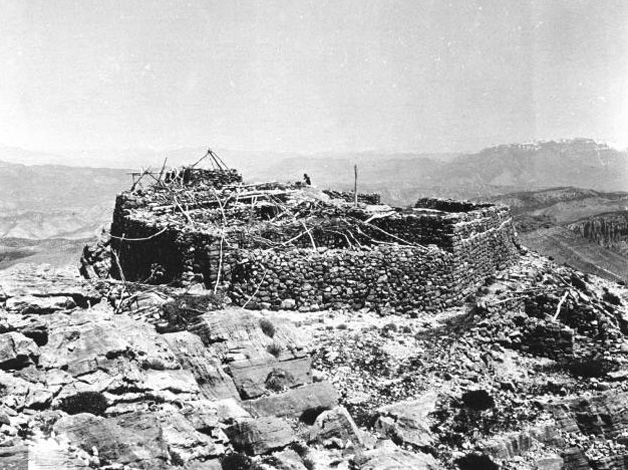
‘Judi Dagh, Cloister of the Ark where Moslems, Jews and Christians would gather yearly to celebrate the Flood of Noah and their rescue through the Ark.’ Gertrude Bell, 1909 [Public domain]
The Book of Genesis, however, says that the Ark came to rest ‘upon the mountains of Ararat’. A site has been identified in this location – Durupınarlvii in eastern Turkey, north of the Iranian border, southeast of Doğubeyazıt and 29 km/18 miles south of the Greater Mount Ararat summit. In 1977, this site was rediscovered and promoted by the amateur archaeologist Ron Wyatt.
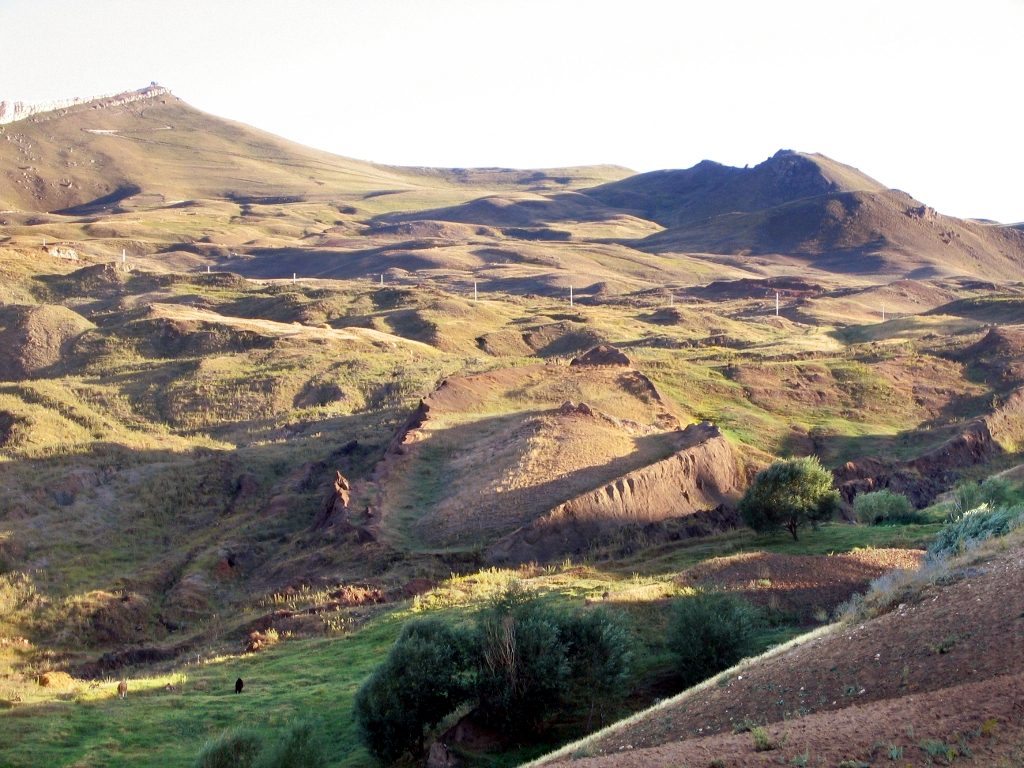
Structure believed to be the remains of Noah’s Ark at Durupinar site in Turkey. Phofo: Mfikretyilmaz https://commons.wikimedia.org/w/index.php?curid=8882591
The Epic of Gilgamesh gives a third location: Mount Nisir/Nimush, known today as Pir Omar Gudrun, in Iraqi Kurdistan. ‘Nishim’ in the Kolbrin could well be a skewed version of ‘Nisir’. The preposition ‘against’ is used in the Kolbrin with its early meaning – ‘facing’, so the text reads ‘upon Kardo in the mountains of Ishtar, facing Nishim’.
Ancient anchor stones
Scattered around the Ararat site are a number of 10-foot-tall andesite stones, each with a chamfered hole near the top, known as the ‘Arzap drogue stones’; these are gigantic versions of the stones which once provided a storm anchor on ancient ships (‘drogue’ is a 17th-century nautical term), a few of which have been found in the Mediterranean and around the Azoreslviii. Critics have pointed out that these stones cannot be linked to the Ark because andesite does not occur in Mesopotamia where the Ark was always assumed to have been built – but andesite is found in Tajikistan.lix Can these be the ‘Great stones … hung from ropes of plaited leather’ described by the Kolbrin? Perhaps one day an intrepid Ark-devotee will scour the Fann Mountains for signs of ancient andesite quarrying or drogue stones that didn’t make the grade.
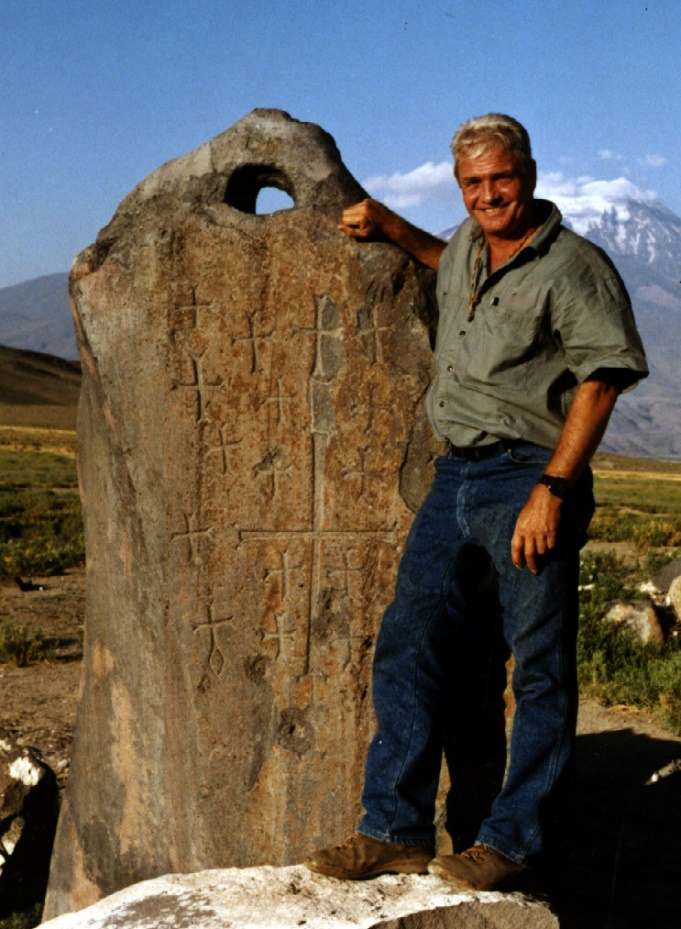
10-foot ‘Drogue stone’ at Durupinar in the Ararat mountains. Photo: Robert C. Michelson in conjunction with the SEPDAC Corporation https://commons.wikimedia.org/w/index.php?curid=8035400
The ongoing dispute between Creationists, archaeologists and skeptics over the Ark’s final resting-place could perhaps be solved if the Kolbrin story in the Celtic books is to be believed. More on this later.
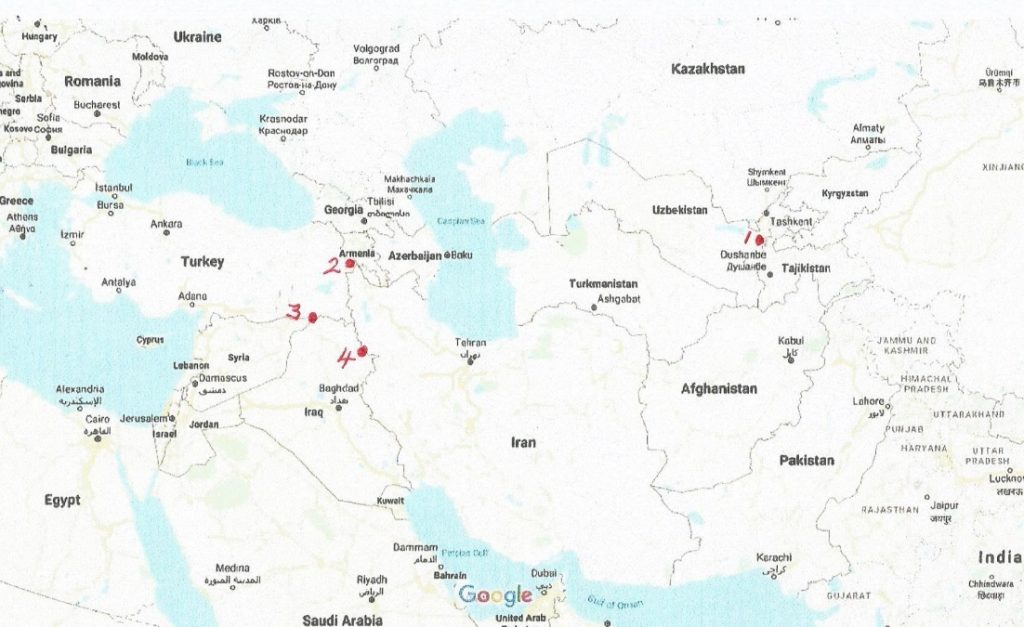
Map indicating (1) Lake Namos/River of Gold region, (2) Durupinar/Ararat site in Turkey, (3) Mount Judi/Cudi Dagh in Iraq and (4) Mount Nimush in Iraqi Kurdistan
Flood survivors
The Kolbrin concludes by saying: ‘Hanok had three brothers by his mother and one by Sadara, two were with him on the great ship and one was saved in Megin.’ This indicates that there were other survivors of the Flood who were not on the great ship. ‘Hanok ruled all the land of Bokah, and his sons, Labeth and Hatana, were born at Nasirah, after the great ship became fast. His brothers divided the water-washed land between them. One went to Tirdana and built a city there, and he ruled the western waters. One ruled the eastern waters and the swamps down to the waters of the sea. The other raised up Eraka [Erech/Uruch – the city later ruled by Gilgamesh] in the midst of them, and he was the greatest. The city of Eraka stood for a thousand years…’
The Floodtale in the Celtic Book of Origins
Now to the Celtic version of the Flood story. ‘It was the Wildland Cultivators’, says the Book of Origins, ‘who gave the floodtale to our housebuilding forebears, but the generation of its happening is lost’. This record seems to be based on an eye-witness account. The narrative starts with the Wildland Cultivators’ account of a terrifying ‘sky-fight’ between two heavenly bodies: ‘the dread figure of Awamkored’ which crawls out of the darkness bringing ‘foul breath’, a ‘grey veil’ and drooling , white cinders, and the figure of the ‘moon-chariot’ containing the ‘bright, beloved figure of Lithalunlx’. The clash when they meet makes ‘the noise of ten thousand rolling thunders, and men bold enough to look were stricken with blindness, and uncovered ears were deafened forever… Those hardy enough… saw the flashing chariot of Lithalun crush the writhing body of the nightcomer, and then saw its vile black blood, thick like resin, fall… as she drove back towards her hidden abode in the recesses of Heaven.’
The scribe writing this comments: ‘Whether it happened before or after the generation of Hestabel and the floodtale, none now truly knows… This is the floodtale which has come down to us from our housebuilding forebears, and it happened in days generations ago, when men were widely divided.’
Here is a slightly abridged version of the Floodtale that follows:
Out into the grey, watery wilderness, where now the restless Western waters roll and heave, there was a place called Tirfola, meaning the Far Western Land. It was a country of high mountains, higher by far than those known to us, and low, green-grassed hills swept down from them to brown, fertile, plowed lands at the sea edge. The folk of Tirfola lived in fine houses, though the roofs were flattened, built on cliff shelves and places high above the fertile valley floor. Ladders went up the side of the houses, for they were entered from the roof…the ways of other people are strange! They hunted the roving deer in open-gladed forests where there were no entangling brambles, and fished in quiet pools of gay, splashing rivers. They plucked the plentiful herbs which grew in manifold variety, there being some for every known purpose. It was indeed a land of peace and plenty.’
These words describe a lost land – lost to the waters of the Atlantic Ocean (the British scribe refers to ‘restless Western waters’). The Book of Gleanings text quoted earlier says that after the Flood, one of Hanok’s brothers ‘went to Tirdana and built a city there, and he ruled the western waters’. There is clearly some link between ‘Tirdana’ and ‘Tirfola’; ‘tir’ is a Brythonic word meaning ‘land’.
One detail leaps out: the houses were entered from the roof. The only ancient culture known for this flat-roofed, laddered and roof-entry building system is that of the mystifying people of Catalhöyük, discovered in Konya, Turkey.

Inside a model of a Neolithic house at Catalhöyük. Photo: Stipich Béla https://commons.wikimedia.org/w/index.php?curid=912753
Catalhöyük is regarded as the world’s oldest town, established around 7,500 BC and occupied for nearly 2,000 yearslxi. An interesting detail in the Kolbrin account is the emphasis placed on growing herbs and plants, which has also been noted at Catalhöyük. If the ancient people of Catalhöyük were the descendants of refugees from Tirfola, they must have led a hard life when they arrived in their new land; leopards and wild beasts are portrayed everywhere in the ruins of Catalhöyük and ancestors were buried under the floors (to prevent them being eaten by predatory beasts outside?)
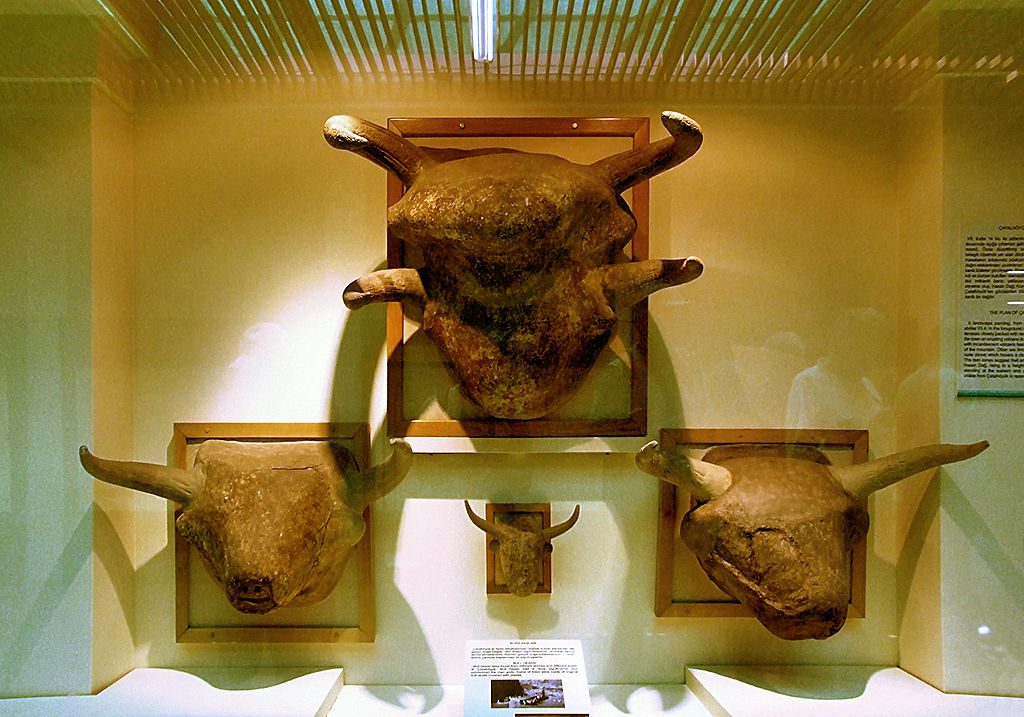
Bull heads from Çatalhöyük, Neolithic, Museum of Anatolian Civilizations, Ankara. Turkey. Photo: Archiwum "Roweromaniaka wielkopolskiego" https://commons.wikimedia.org/w/index.php?curid=1705359
Two days of dread
‘The day came, as come it always must whenever peace and plenty abide, for then Earth displays a defect in her instructiveness, when the soothsayers saw kolkers in the night skies, but they were unable to agree among themselves as to what these portended… The day came when sleeping Earth awoke to a great silence and stillness… All was hushed and motionless, waiting. Then the soaring sun brought low-moaning winds which stirred the trees and grasses to rustling, murmuring life, but all living creatures huddled closer together. The skyroof above was darkened and lowered, it was ruddily-hued and gave out sharp, whipcracking sounds, as though it would break asunder, with now and then a shrill, long-drawn cry. In heart-thumping procession, awesomely-figured sky-gods never before seen, passed overhead. Men lived through two fear-struck days of dread, not knowing what to expect, during which time there was no true night, one heart-stopping sight after another passing before their horror-filled eyes.’
The words ‘for then Earth displays a defect in her instructiveness’ suggests that the author has read several earlier records of global disasters which have occurred without warning to human beings oblivious to threat in the midst of peace and plenty.
The nearest to a definition of ‘kolker’ is the Dutch/Frisian meaning of ‘colke’ – ‘a whirlpool or pool’; phenomena described as ‘whirlpools in the sky’ have been photographed and recorded online.
Fountain spouts pouring from the sky
‘When darkness did fall it… it was that form of darkness known as the smothering cloak of Thunor, though never before had it spread so wide. Water streamed downward from the fountain-spouts of the sky, not as rain falls but as water drops out from a pail upturned. Neither was it the pure, true rain, it was tainted with bitter blood from some strange battlefield in the vast sky-spaces and contained broken pieces of the rainbow. The sky-roof itself was borne down to the very surface of the seething waters, and Mother Earth cowered beneath it… A vast black cloud was drawn like a curtain across the sky-roof, stretching from horizon to horizon. Rising above it were strange billows of flame and smoke, though what the fire consumed it is not possible to even guess, for all know water does not burn. Then all things ceased movement… the stillness of heart-hammering fear.’
A high wave wall of dark waters
‘Then, with awful suddenness, came a high wave wall of dark, white-fang-edged waters, sweeping swiftly along in fearsome irresistibility. It carried everything before it, as a broom sweeps the floor, and accompanying it was a high-borne note, long-drawn out. Behind it, upon the seething waters, all the fruits of the land, house debris, trees, bloated dead animals and humans floated upon the wild, wide waters. There was an earthy-brown, foamy scum which drifted strangely over the surface, not sinking, yet not like oil, for it was gritty, it was irregular and held together, it was like the scum on a fuller’s tub.’
Seven days of torrential rain
‘There was a great downpouring of rain which stopped after seven days, then the sky-roof rose back into its proper place and our fear-struck forebears saw once more the blessed light of day. They stood upon their drenched mountainsides and saw great trees, the like of which had never before been seen, float past. Hell-formed, hideous things came up from the depths and, swelling, burst on the surface. There were fearful sea monsters and great whirlpools, terrible things from unknown places. Wild creatures were washed about, dead or dying. The surging seas tore between the high mountains in great rip-tides of dirty water.’
Compare the description above with the one in Gleanings: ‘The floodgates of Heaven were opened and the foundations of Earth were broken apart.’ This happened before the rain started, so clearly, something far more violent than rain is being described, especially since ‘it was tainted with bitter blood… and contained broken pieces of the rainbow’ (could this have been oil?) In The Worldwide Flood, Michael Jaye attempts to work out how great the inundation was and, estimating an incoming object (IO) with a diameter of 2,500 km (the Kolbrin, incidentally, says that the Destroyer ‘covers about a fifth part of the sky’lxii), he thinks that the IO occupied a volume of 5.58 * 10⁹ km³. He says: ’To approximate the equivalent depth of water delivered, the volume can be divided by the present oceans’ surface area. Since the earth’s oceans are reported to cover 3.62 * 10⁸ km², the IO delivered an average ocean water depth of 3.57 (more than two miles)… The newly introduced waters flooded the planet, and they did so from the former abyss upward… Coupled with the vast new waters and ensuing changes to weather patterns, the IO induced irreversible ecosystem and climatic changes that geologists recognize as the YD [Younger Dryas] event. In short, the worldwide flood and the YD event are synonymous.’lxiii
Ark number 1 – the Swimming House
‘Standing on their hilltops our frightened forebears saw the swimming house, made fast against the sea, come up to the land, and out from it came men and beasts from Tirfola. It was built as a house on a high platform, standing well above the waters. When they had landed and made themselves secure, the black-raimented strangers built a tall tower of stone upon which they kept an ever-burning fire, to honour the gods who brought them to safety. It was said that if the fire ever went out, the waters would rise again.’
This house on a high platform sounds just like the traditional image of Noah’s Ark everyone knows, with its men and beasts.
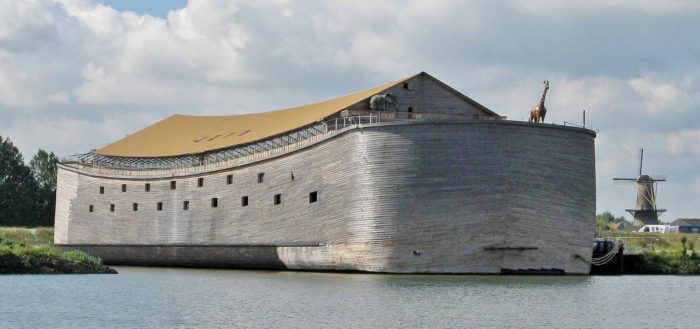
Noah’s Ark reconstruction masterminded by Johan Huiber, Dordrecht, Netherlands. Photo: Frans Berkelaar https://commons.wikimedia.org/w/index.php?curid=82322714
Ark number 2 – the Brimcofer
‘Upon the surging waters was another wave-tossed craft, the great Brimcofer of Hestabel the Wildwave Wanderer, Slayer of Niktoran the waterbeast, Worker of Strange Metals, who married Newlyn of Warnwilt, daughter of Manwidan, far famed for her beauty… The son of Hestabel was the temple-protecting, three-spirited Esures who made his home in the Great Oak where to this day he is worshipped as the god of beer and greenery. The tale tellers are not at ease with Hestabel and Esures, whether they were god or men, but in some men the division is not clear. Perhaps gods are made by the regard of men.’
When ‘Brimcofer’ is split up into its component parts, it reveals its ancient meaning: ‘Brim’ is a now-obsolete Middle English poetical word meaning ‘flood’ or ‘sea’. ‘Cofer’, now also obsolete, once meant ‘a coffer or ark’, and was used of Noah’s Ark.
Esures is a skewed version of Esus or Hesus, a Celtic deitylxiv. At this point the author sounds uncertain of the material he is writing about because it comes from an unfamiliar culture.
Surviving the Great Flood
Several Ark location traditions are known to exist, so it is intriguing that the Kolbrin describes two ships. Then why is only one Ark recorded elsewhere? It is possible that if the Kolbrin version was written at an early date, confusion might have arisen between the time it was written and later versions when memories were cloudier. Whatever the reason, the Celtic Books are in no doubt that two great ships washed up: one came to rest on Mount Cudi ‘facing’ Mount Nisir, so the other probably ended up among the Ararat mountains. The sites are a couple of hundred miles apart – sufficiently close to one other for Flood survivors to preserve a memory of the two locations. This raises the distinct possibility of more Arks and more survivors across the world than those recorded in the Sumerian, Babylonian and Biblical accounts.
That the Kolbrin contains these records detailing the triumph of human ingenuity over appalling odds is astonishing. They deserve further exploration.
+The author welcomes correspondence with readers via [email protected]. Kolbrin text courtesy of The Culdian Trust
References
i The Worldwide Flood: Uncovering and Correcting the Most Profound Error in the History of Science, Michael Jaye (Archway Publishing, 2017).
ii https://www.youtube.com/watch?v=MHiNd-JE59Y
https://www.smithsonianmag.com/science-nature/evidence-for-a-flood-102813115/
iii Kolbrin, Book of Gleanings, 4:1
iv The Kolbrin, Book of Gleanings, chapters 4, 5:1-2
viii The Kolbrin, Celtic Books, Book of Origins, chapter 3
ix Introduction, The Kolbrin, Copyright 1994 by The Hope Trust
xFrom Gk. kaukhasis, from Scythian kroy-khasis, lit. ‘(the mountain) ice-shining/white with snow.’, c.f. Naturalis Historiae, Pliny the Elder (AD 77-79).
xiThe Kolbrin, Gleanings, chapters 5-10.
xii The Kolbrin, Gleanings, chapter 6: 30
xiiiThis Sisuda is almost certainly a skewed version of ‘Ziusudra’ since, following on from Lugalbandur and Dumuzid, he was the last king to rule from Uruch/Erech before the Flood. There was a King Susuda, but he ruled thousands of years later and from Kish.
xv For more information about how in earliest times the Children of God lived far longer lives and the Children of Men had shorter life-spans, and how these changed, see https://grahamhancock.com/whitemany7/
xvii Magicians of the Gods, Graham Hancock, pages 23, 67-8
xviii The 3rd millennium BC Akkadian Epic of Atrahasis and the ancient Mesopotamian Epic of Gilgamesh both mention Šuruppak but use the names Atrahasis (Akkadian) and Ut-napišhtim (ancient Mesopotamian/ Gilmamesh) instead of Ziusudra, while a later version by the Babylonian writer Berossus names Xisuthros [Ziusudra] as the king of Šuruppak/Shuruppak.
xixIf the two accounts in the Celtic Book of Origins, mentioned later in this article, belong together, then ‘Lady of the Night’ describes the Moon.
xxii The Sumerians: their history, culture and character, Samuel N. Kramer.
Ancient History of Aratta-Ukraine, Dr Yuri Shilov.
xxiii Ancient History of Aratta-Ukraine, Dr Yuri Shilov.
xxiv The Kolbrin, Creation 7:2
xxv Genesis 5:21–31
xxvi Underworld: Flooded Kingdoms of the Ice Age, Graham Hancock (Michael Joseph, 2002)
xxix Sheepskins were used to filter river gold in ancient times, as alluded to in the story of Jason and the Golden Fleece.
xxxv http://www.chinaknowledge.de/History/Altera/miguo.html http://www.chinaknowledge.de/History/Altera/anguo.html
http://www.chinaknowledge.de/History/Altera/caoguo.html
xxxix Into the Land of Bones: Alexander the Great in Afghanistan, p.70, Frank L. Holt
xli Footnote in Tajikistan: A Political and Social History, Kirill Nourzhanov, Christian Bleuer:
Khujandnoma, Yo qissaho az ta’rikhi Khujand va Khujandiyon, Orifjon Yahyozodi Khujandi, (Khujand: Nashriiyoti davlatii ba nomi R, Jalil, 1994), pp.7-8. The Tajiks’ descent from Noah is also referred to in The Ruhnama (The Book of the Soul) by the one-time dictator of Turkestan, Saparmurat Niyazov.
xlii Genesis 6: 14-16
xliii https://communitiesfirst.net/wp-content/uploads/2014/11/aw-preparing-for-resource-extraction-jul-2014.pdf
xliv https://asiaplustj.info/en/news/tajikistan/economic/20190828/asphalt-gold-and-drinks-emomali-rahmon-opened-three-new-enterprises-in-dushanbe
xlv Timaeus, Plato, narrating the visit of Solon of Athens to Egypt, two centuries before Plato’s time, transl. Francis Cornford.
xlviNaturalis Historia, book 2, Pliny the Elder
xlviii For the LORD will pass through to smite the Egyptians; and when he seeth the blood upon the lintel, and on the two side posts, the LORD will pass over the door, and will not suffer the destroyer to come in unto your houses to smite you. Exodus 12:23
xlix A dreadful sound is in his ears: in prosperity the destroyer shall come upon him. Job 15:21
l Mankind in Amnesia, Immanuel Velikovsky
li L’antiquité dévoilé par ses usages, Nicolas-Antoine Boulanger, Amsterdam, 1766
liithe land of Karda https://www.scirp.org/journal/PaperInformation.aspx?PaperID=49273
liiiThis might be a skewed version of ‘Ishtar’. The Burney Relief in the British Museum shows the goddess Ishtar standing on a base of mountains.
livIf the Kolbrin predates Judaism, then ‘the land of God’ refers to something other than the Judaic God. The Kolbrin says that Osiris came from the Land of God.
lv From Eden to Exile, David Rohl
lvii The site is named after Turkish Air Force Captain İlhan Durupınar. In 1959 he saw and photographed it while on a mapping mission for NATO.
lviii Featured in Atlantis Rising, a 2017 documentary by the film-makers James Cameron and Simcha Jacobovici
lx Lithalun appears only as the name of a quarry in Wales, named after the site which is of archaeological interest. That the name exists is intriguing, since the Welsh language preserves so many extremely ancient names.
lxi Catalhöyük: The Leopard’s Tale, Ian Hodder (Thames & Hudson, 2011) http://factsanddetails.com/world/cat56/sub362/item1504.html
lxii The Kolbrin, Manuscripts, 5:5
lxiii The Worldwide Flood: uncovering and correcting the most profound error in the history of science, Michael Jaye (Archway Publishing, 2017)
- The Unknown Gilgamesh, 2022-07-07
- Osiris the Great One, 2022-03-31
- Unlocking the Mysterious Kolbrin: Sacred and Scandalous Egypt, 2021-09-30
- The Three Lost Motherlands of Egypt, 2021-02-01
- Where we humans come from, 2020-07-04
- From Egypt to Punt and distant Ophir, 2020-03-05
- The Kolbrin | The Worldwide Flood: Who, Why, When And Where
- The Kolbrin on The Pharaoh’s Folly at Amarna, 2019-06-12
- The Kolbrin On Immortality: How Egypt Regained the Secret of the Ages, 2019-01-29
- PART 2: The Kolbrin On Giants And The Nephilim, 2018-10-29
- PART 1: The Kolbrin On The Sons Of God and Daughters Of Men, 2018-09-17
- The Kolbrin: On Who Built The Great Sphinx, And Why, 2018-03-10
- The Kolbrin’s Origin Of The British, 2017-09-30
- Was This Eden? Locating The Kolbrin’s Gardenplace, 2016-07-29
- The Kolbrin’s King Akhenaten story, 2016-05-18
- The Kolbrin’s Exodus Story – Ancient Egyptian Version, 2016-02-09
- Guide to the Kolbrin, 2015-10-17
12 thoughts on “The Kolbrin | The Worldwide Flood: Who, Why, When And Where”
Comments are closed.








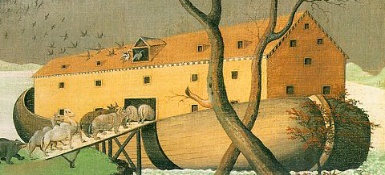
The hole in the top of the stone does not appear to be designed for heavy load. It would make more sense as a stone mason or sailor to have the point of attachment in the middle and without any perforation which would greatly weaken the stone.
The twenty days of the Maya precisely correlate with the first 20 I-Ching hexagrams, and the 9th day and hexagram speak of the aversion of tragedy by water with the Quiche Maya descriptor going so far as to say “survives rains and floods”. Chapter six Genesis also correlates, as the chapters follow precisely the trecenas. and 6 is Kawoq which is the 9th day. This immediately follows the trecena of “ruler of physical death”, in chapter 5 and is the only chapter where we find ‘and he died” written 8 times.
The destroyer of Exodus is a different one as that book follows the 20 days in order by theme twice round to make 40 chapters. This makes 12 the day of IQ, and is also a day of “rapid tragedy” or the “great go and the little come” in the I-Ching. In that Genesis simultaneously follows the 36 decans in precise order then chapter 6 is the third decan of Taurus, and the chapter 9 third decan Gemini which is Pheonix, the rebirth.
There is no way these drogue stones would have been attached by just one small hole at the top. The stones would have been tightly criss-crossed with strong ropes ‘of plaited leather’ and the hole would have been there as the basic link. Over thousands of years, the stones scattered in the Ararat mountains have been chipped away at by devoted visitors taking souvenirs, so we have little idea what they originally looked like – but it looks as if some of them might have had a concave shape.
This is very well written and incredibly interesting. I can’t help but wonder how they knew when to build a boat, where to build it and how to make it stable for a cataclysm such as this.
The main issues to note are 1) the Great Flood was a celestial event in which the rains came from above and that it was 2) world wide in scope. The prediction was as with many things in historical accounts in which we see the end result (the prediction within a small group) but not the source (an outside source notified Noah). It is not hard to deduce that this was due to a comet. Then one has to surmise that someone somewhere knew of the orbit of a large comet approaching in which the earth would spend a long period of time in the tail, but that this was not generally known. If earth were to pass through a known recent comet tail such as the tail of Comet Hale Bopp, it would have taken about 40 days given earth’s orbital velocity (of course Hale Bopp was on a far different orbit but this is used as an example to illustrate the comet tail dimensions and time for earth to pass through it). So the story of 40 days and 40 nights of torrential rain from above is not out of scope at all, in fact it is quite plausible. Advanced warning would have given Noah years to prepare, gather the animals and float away when the rains started. As Yvonne notes in the beginning, educational programs today do not even mention the Great Flood. How could the most formative event in human history be completely ignored? Hopefully this insightful article will help bring scholars and educators to terms with reality.
I be live I have proof of the flood waters moved an produced some of the formations we now think of as glacier deposit. I’ve been in the oil industry for 20yrs an have seen many different regions of the Ohio river valley an sounding states. I can show any one with interest megagilths in Ohio. And multi formations on the surface that I can’t not explain or even understand how they are there. From 50 to 100 ton stones too mounds that are the size of 10 story structure. I am very familiar with the history of this region an why it is important that I can draw some attention to this before it is lost to antquitie.
As someone in the oil industry, you might be interested in the research done by Randall Carlson. Go to Youtube, do a search for his name and you’ll find him discussing areas of North America affected by extremely climatic change with Graham Hancock and Joe Rogan, as well as videos on his research.
Yvonne,
Your articles are fantastic. I used to as a source in my presentation on the twice born to my masonic lodge. Thank you for all of your hard work. I sourced you many times and directed everyone to your work. Your amazing and I hope to meet you one day and have you sign my copy of the Kolbrin
Sincerely
Nathan Moran
Thanks for your comments, Nathan – but do bear in mind that until the provenance of the Kolbrin’s Egyptian and Celtic books is established, the material in it cannot be used as firm evidence of any prehistoric or historic events.
Was thinking about Australian aboriginal and south African native. Australia is low lying land mass and does not seem to been affected as much from this past event as the northern latitudes were.Australian aboriginal have been on continent for at least 60 thousand years but we’re not wiped out. I wonder if aboriginal Australian
MemoriseD this event.
Would seem Australian Aborigines did memorise natural events from recent to 18000bc. They have witnessed natural rise and fall of oceans and tsunamis in some tribes. But not sure if they have accounts of fireballs crossing sky pillars of smoke etc. Would seem southern latitudes of earth not as effected as much by this close encounter event that wiped out many species in North latitude areas. …
https://www.scientificamerican.com/article/ancient-sea-rise-tale-told-accurately-for-10-000-years/
And this..
http://www.everythingselectric.com/flood-mythology/
I do not know if genetic memory has been proven but the part where it mentions the stars have moved causes me to wonder. As I became older an interested in observing the constellations I started to have fear of seeing all of the stars begin to move. I recently talked with a very intelligent friend about this and he explained how irrational that I should be fearful of something that can not happen. I have come to the belief that on some level I know that this can and has occurred.
Shame there isn’t a “like” button – this is great stuff! However, regarding Ron Wyatt’s work on the Ararat ‘Ark’ and other biblical sites, a quick web search will show this has been trashed by archaeologists, geologists and even some Chritians (including the notorious ‘Truth in Genesis’website which is some going!)
Stories, especially those passed on by mouth, tend to get exagerated over time, so the idea that there was only one ark and one surviving family is quite unlikely and it’s interesting to hear evidence of others.